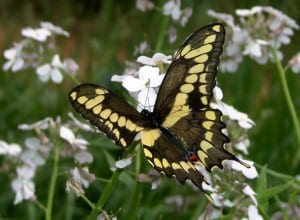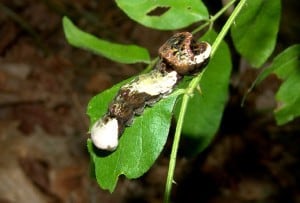Here is Tim Dyson’s report on the status of Giant Swallowtail butterflies this summer. The Giant Swallowtail is a newcomer to the Kawarthas and Canada’s largest butterfly.
“Starting on May 30th, (first brood, which likely had over-wintered as pupae, I would expect), I saw Giant Swallowtails in the region from Havelock to Stoney Lake to Lakefield to Warsaw, but most in the Havelock/Round Lake area. That flight lasted about 3 weeks, during which time I saw about 30, though most were seen during the first week of June. I didn`t see any that I can remember after June 20th or thereabouts.
The second flight began for me with a nice fresh one near South Bay on Stoney on July 31st, and I`ve seen three more since. Another off Northey`s Bay Road between Jack`s Creek and Eel`s Creek, one along Round Lake Road, and the other was not far from Belmont Lake about five kilometres s/w of Cordova Mines. This, so far, fits the pattern of last year.
Last year of course, we suffered drought conditions, and much of the Prickly Ash foliage (on which they lay their eggs) was poorly affected, and those that grew in mostly full sun were quite yellowed and drying up. The shaded ones were some better, but not much. We did have a few patches in deep shade that had abundant dark green healthy leaves, and larvae there were already in final instar. We moved some others from poor foliage in the hot sun to this greener spot, and the larvae thrived in the new location. I believe that they must descend the host plant, and pupate elsewhere, (perhaps quite low), for the winter, as we never did find any pupae on the host shrubs.
This summer however, the foliage on all Prickly Ash is quite good, and many even have the little green “limes” on the undersides of the upper branches. Wow, what I nice smell they produce when rubbed!! Anyway, I expect to find many larvae again later in the month. Late August and the first half of September seems to be the time to look for them, (if last year was an indication.)
Tim Dyson
Categories: Sightings

